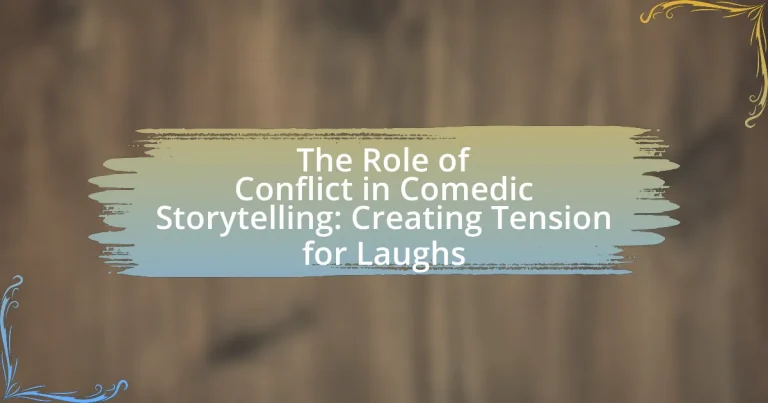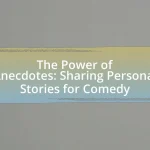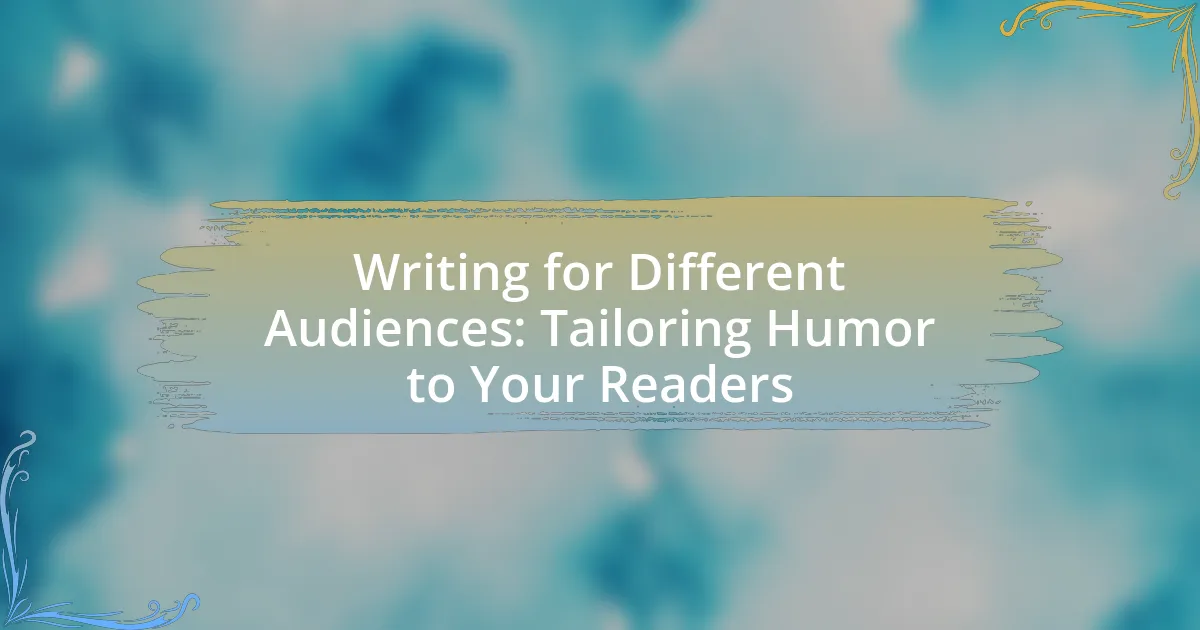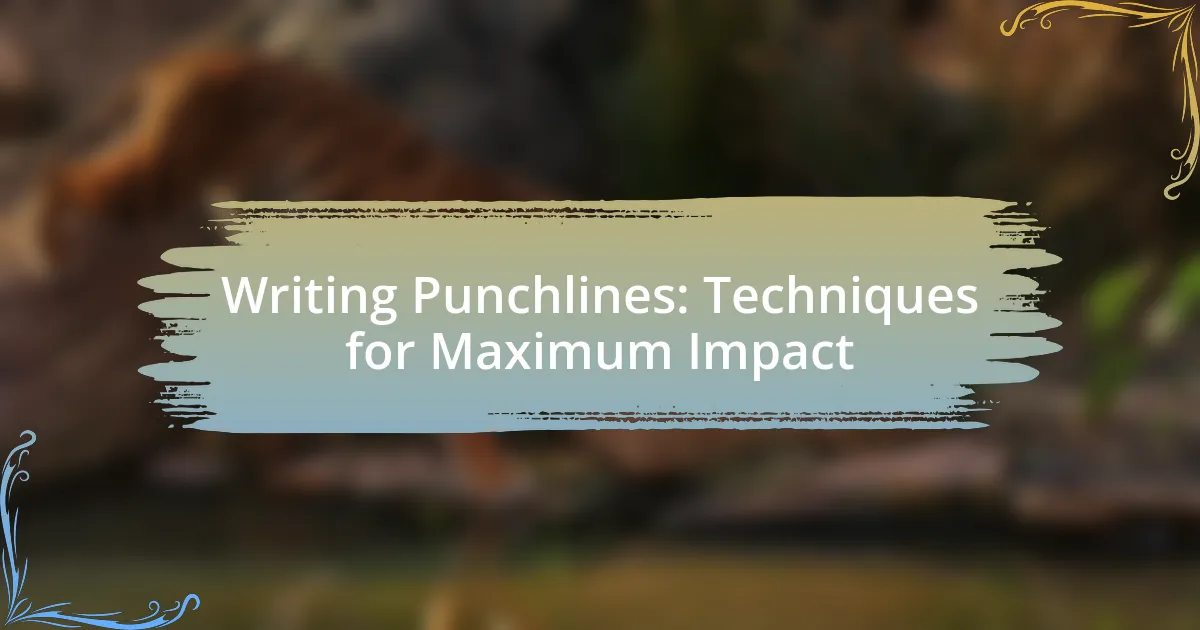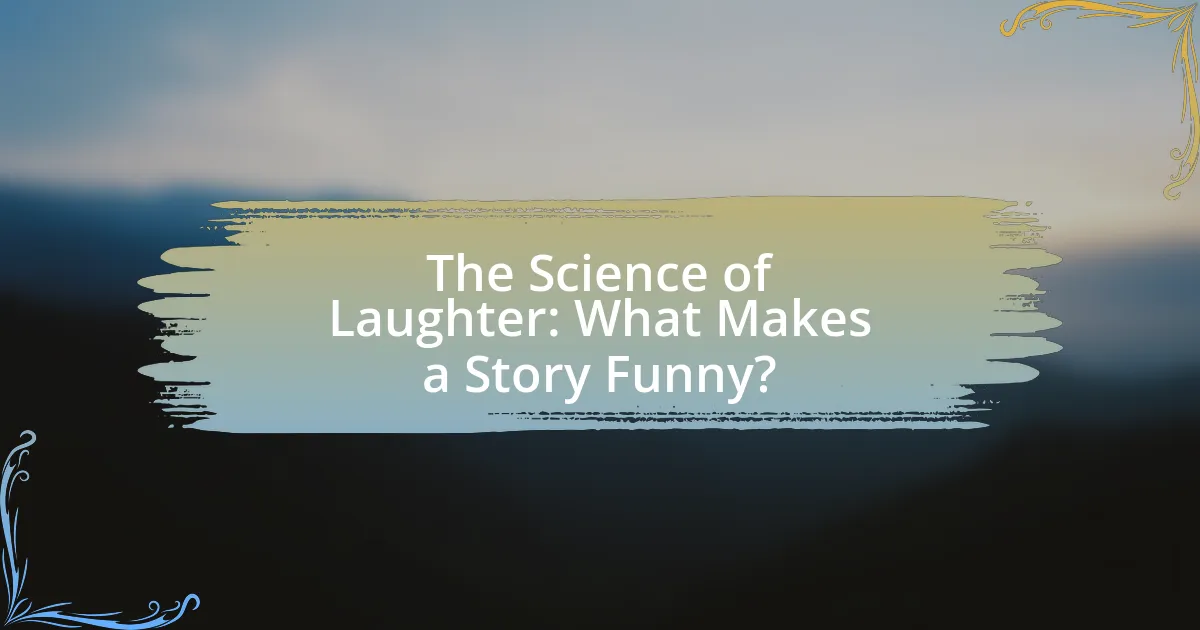The article examines the role of conflict in comedic storytelling, emphasizing how tension generated by opposing forces leads to humor. It outlines various types of conflict, including character vs. character, character vs. society, and character vs. self, and discusses how these conflicts create comedic situations through misunderstandings and absurdities. The resolution of conflict is highlighted as a key element that enhances comedic effect, often through unexpected outcomes that subvert audience expectations. Additionally, the article explores psychological mechanisms behind humor, such as incongruity and relief, and provides practical tips for effectively integrating conflict into comedic narratives.
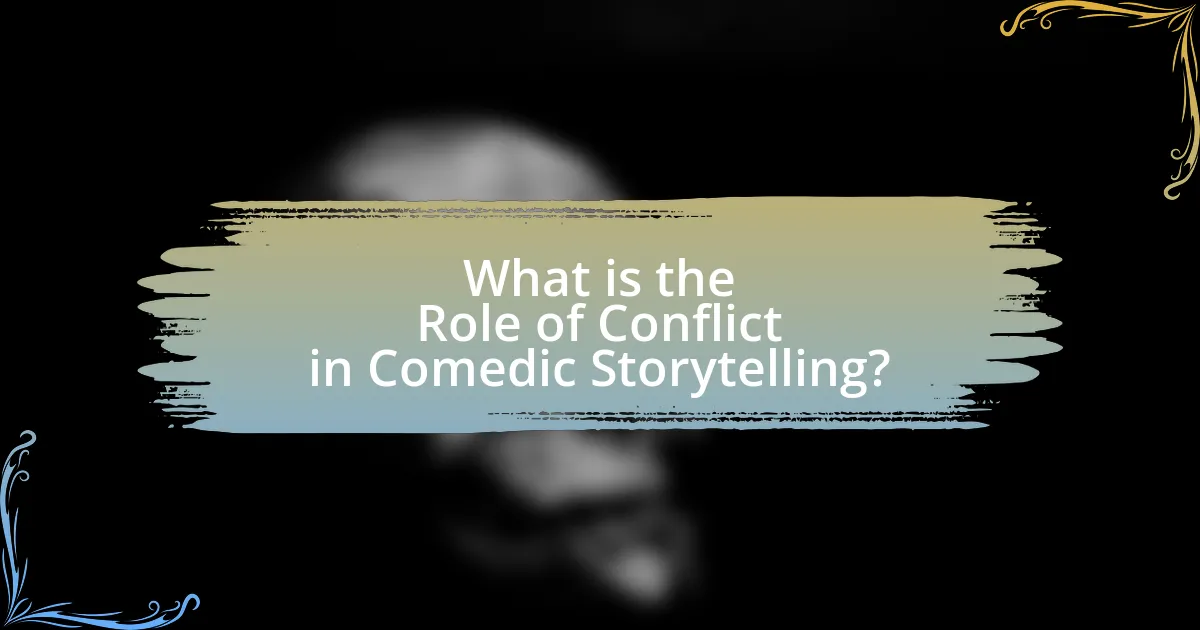
What is the Role of Conflict in Comedic Storytelling?
Conflict serves as a crucial element in comedic storytelling by creating tension that leads to humor. This tension arises from the clash of opposing forces, such as characters with conflicting goals or misunderstandings, which sets the stage for comedic situations. For instance, in classic sitcoms, the miscommunication between characters often escalates into absurd scenarios, generating laughter through the resolution of these conflicts. Research indicates that humor often emerges from incongruity, where the unexpected outcomes of conflicts surprise the audience, leading to amusement. Thus, conflict not only drives the narrative forward but also enhances comedic effect by providing a framework for humor to unfold.
How does conflict contribute to humor in storytelling?
Conflict contributes to humor in storytelling by creating tension that can lead to unexpected resolutions or absurd situations. This tension often sets the stage for comedic moments, as characters navigate challenges in exaggerated or ironic ways. For example, in sitcoms, misunderstandings or rivalries often escalate to ridiculous levels, resulting in humor derived from the characters’ reactions and the absurdity of the situations. Research indicates that humor often arises from incongruity, where the resolution of conflict defies audience expectations, thus eliciting laughter.
What types of conflict are commonly used in comedic narratives?
Comedic narratives commonly utilize three types of conflict: character vs. character, character vs. society, and character vs. self. Character vs. character conflict often involves humorous misunderstandings or rivalries, exemplified in sitcoms where characters engage in witty banter or compete for attention. Character vs. society conflict highlights the absurdities of social norms, as seen in films that parody cultural expectations. Character vs. self conflict showcases internal struggles, often leading to comedic situations where a character’s insecurities or indecisions result in humorous outcomes. These conflicts create tension that ultimately leads to laughter, reinforcing the comedic storytelling framework.
How does the resolution of conflict enhance comedic effect?
The resolution of conflict enhances comedic effect by providing a satisfying conclusion that often subverts expectations, leading to humor. When conflicts are resolved in unexpected or absurd ways, it creates a contrast between the tension built up during the conflict and the lightheartedness of the resolution, which can evoke laughter. For example, in sitcoms, misunderstandings often escalate to a peak before being resolved in a way that highlights the absurdity of the situation, reinforcing the comedic narrative. This technique is supported by the incongruity theory of humor, which posits that humor arises when there is a discrepancy between what is expected and what actually occurs.
Why is tension important for generating laughs?
Tension is crucial for generating laughs because it creates a buildup of anticipation that is often resolved through humor. This anticipation engages the audience, making them more receptive to the punchline or comedic twist. Research in psychology indicates that humor often arises from the incongruity between expected outcomes and actual results, which tension effectively sets up. For example, a study by Martin et al. (2003) found that the element of surprise, which is a product of tension, significantly enhances the perception of humor. Thus, the interplay of tension and resolution is fundamental in comedic storytelling, as it transforms discomfort into laughter.
What psychological mechanisms are at play when tension leads to laughter?
Tension leads to laughter primarily through the psychological mechanisms of incongruity and relief. Incongruity theory posits that humor arises when there is a discrepancy between expectations and reality, creating a surprise that triggers laughter. For instance, a setup that builds tension may lead the audience to anticipate a serious outcome, but a punchline that subverts this expectation results in humor. Relief theory complements this by suggesting that laughter serves as a release of built-up psychological tension, allowing individuals to alleviate stress or anxiety. This is evident in situations where humor follows a tense moment, providing a cathartic experience. Research supports these mechanisms; for example, a study by Martin et al. (2003) found that laughter can reduce physiological stress responses, reinforcing the idea that humor acts as a coping mechanism in tense situations.
How does timing influence the effectiveness of tension in comedy?
Timing significantly influences the effectiveness of tension in comedy by determining when a punchline or comedic relief is delivered in relation to the buildup of tension. Effective timing creates a rhythm that enhances the audience’s anticipation, making the eventual release of tension more impactful. For instance, studies in comedic timing, such as those by researchers like John Cleese, highlight that a well-timed pause before a punchline can amplify the humor by allowing the audience to fully absorb the preceding tension. This principle is evident in stand-up routines where comedians often use pauses strategically to heighten suspense before delivering a joke, resulting in greater laughter.
What are the key elements of comedic conflict?
The key elements of comedic conflict include misunderstanding, incongruity, and character flaws. Misunderstanding arises when characters misinterpret situations or each other, leading to humorous scenarios. Incongruity occurs when there is a mismatch between expectations and reality, often resulting in surprise and laughter. Character flaws, such as arrogance or naivety, create situations where characters find themselves in absurd or exaggerated predicaments, enhancing the comedic effect. These elements work together to generate tension and humor, making comedic storytelling engaging and entertaining.
How do character dynamics create conflict in comedic storytelling?
Character dynamics create conflict in comedic storytelling by establishing contrasting personalities and motivations that lead to misunderstandings and humorous situations. For instance, a straight-laced character may clash with a carefree, impulsive character, resulting in comedic tension as their differing approaches to situations create chaos. This dynamic often leads to scenarios where the audience anticipates the inevitable clash, enhancing the comedic effect. Research indicates that humor often arises from incongruity, where the unexpected outcomes of character interactions generate laughter, as seen in classic sitcoms like “Friends,” where character differences drive plotlines and comedic moments.
What role does situational irony play in comedic conflict?
Situational irony serves as a crucial mechanism in comedic conflict by creating unexpected outcomes that contrast with characters’ intentions or expectations. This discrepancy generates humor, as audiences find amusement in the unpredictability of events, which often leads to absurd or exaggerated situations. For example, in classic comedies like “The Office,” characters often find themselves in ironic situations where their plans backfire, leading to humorous consequences that highlight their flaws or misunderstandings. This use of situational irony not only enhances comedic tension but also deepens character development, as viewers witness the gap between intention and reality, making the humor more relatable and impactful.
How can conflict be effectively integrated into comedic storytelling?
Conflict can be effectively integrated into comedic storytelling by creating situations where characters face absurd challenges or misunderstandings that lead to humorous outcomes. This approach utilizes the tension generated by conflict to enhance comedic timing and surprise, often resulting in laughter from the audience. For example, classic sitcoms like “Friends” and “The Office” leverage misunderstandings and interpersonal conflicts to create comedic scenarios, demonstrating that the resolution of conflict can lead to humorous revelations or character growth. Research indicates that humor often arises from incongruity, where the unexpected resolution of conflict leads to comedic relief, thus reinforcing the effectiveness of conflict in eliciting laughter.
What are common pitfalls to avoid when using conflict in comedy?
Common pitfalls to avoid when using conflict in comedy include relying on stereotypes, which can alienate audiences, and failing to resolve conflicts in a satisfying manner, leading to confusion rather than humor. Stereotypes often reduce complex characters to one-dimensional traits, diminishing the comedic impact and risking offense. Additionally, unresolved conflicts can leave audiences feeling unsatisfied, as humor often relies on a clear setup and payoff. Research indicates that effective comedic conflict should balance tension with resolution to maintain audience engagement and laughter.

What are the different types of comedic conflict?
The different types of comedic conflict include character vs. character, character vs. society, character vs. self, and character vs. nature. Character vs. character conflict arises from interactions between individuals, often leading to humorous misunderstandings or rivalries. Character vs. society conflict involves an individual’s struggle against societal norms or expectations, which can create comedic situations through satire or exaggeration. Character vs. self conflict focuses on internal struggles, such as indecision or self-doubt, often resulting in comedic self-reflection. Lastly, character vs. nature conflict presents characters facing absurd or exaggerated natural challenges, leading to humorous outcomes. These types of conflicts are essential in comedic storytelling as they create tension that ultimately leads to laughter.
How do internal conflicts manifest in comedic storytelling?
Internal conflicts in comedic storytelling manifest through characters grappling with their desires, fears, and moral dilemmas, often leading to humorous situations. For instance, a character may struggle between the desire to be honest and the fear of hurting someone’s feelings, resulting in awkward and funny scenarios as they attempt to navigate the situation. This tension creates comedic moments, as the audience relates to the character’s internal struggle, amplifying the humor through exaggerated reactions and misunderstandings. Comedic storytelling often relies on these internal conflicts to drive the plot and develop character arcs, making the humor more relatable and impactful.
What examples illustrate internal conflict in comedy?
Examples that illustrate internal conflict in comedy include characters grappling with their desires versus societal expectations, as seen in the film “The 40-Year-Old Virgin,” where the protagonist struggles with his fear of intimacy while wanting to connect with others. Another example is in the TV show “The Office,” where Michael Scott often faces internal dilemmas about being a good boss versus seeking personal validation, leading to humorous yet relatable situations. These examples highlight how internal conflicts create tension that drives comedic narratives, allowing audiences to engage with the characters’ struggles while eliciting laughter.
How can internal conflict drive character development in humor?
Internal conflict can drive character development in humor by creating relatable situations that highlight the absurdity of human behavior. When characters grapple with conflicting desires or beliefs, their struggles often lead to comedic outcomes, as audiences find humor in the tension between their intentions and actions. For example, a character torn between wanting to impress others and their natural awkwardness can lead to humorous scenarios that reveal deeper truths about social anxiety. This dynamic not only entertains but also fosters empathy, as viewers recognize their own internal conflicts reflected in the character’s journey.
What external conflicts are prevalent in comedic narratives?
External conflicts prevalent in comedic narratives often include misunderstandings, social class clashes, and romantic rivalries. These conflicts create tension that drives the humor in the story. For instance, misunderstandings between characters can lead to humorous situations, as seen in classic comedies like “Some Like It Hot,” where mistaken identities result in comedic chaos. Social class clashes, such as those depicted in “The Fresh Prince of Bel-Air,” highlight the absurdities of wealth and privilege, generating laughs through exaggerated scenarios. Romantic rivalries, often portrayed in films like “10 Things I Hate About You,” create comedic tension as characters navigate love triangles and competing interests. These external conflicts are essential in shaping the comedic narrative and eliciting laughter from the audience.
How do misunderstandings create comedic situations?
Misunderstandings create comedic situations by generating conflict through miscommunication, leading to unexpected and humorous outcomes. When characters interpret situations or dialogue incorrectly, it often results in absurd scenarios that highlight the gap between intention and perception. For example, in classic sitcoms, a character may overhear a conversation and jump to a false conclusion, prompting a series of comedic events that escalate the misunderstanding. This technique relies on the audience’s awareness of the truth, creating dramatic irony that enhances the humor. Studies in comedic theory, such as those by John Morreall, indicate that humor often arises from incongruity, where the unexpected nature of misunderstandings serves as a catalyst for laughter.
What role do societal norms play in external comedic conflicts?
Societal norms serve as a framework that defines acceptable behavior, and when characters violate these norms, external comedic conflicts arise. These conflicts often stem from the juxtaposition of societal expectations and individual actions, leading to humorous situations. For instance, in sitcoms, characters may find themselves in absurd scenarios that highlight the absurdity of social conventions, such as misunderstandings or breaches of etiquette. This comedic tension is effective because it resonates with audiences who recognize the norms being subverted, creating a shared sense of humor. The effectiveness of this approach is evident in shows like “The Office,” where characters frequently navigate the complexities of workplace norms, resulting in comedic outcomes that reflect societal expectations.
How do conflicts between characters enhance comedic storytelling?
Conflicts between characters enhance comedic storytelling by creating tension that leads to humorous situations. When characters have opposing goals, misunderstandings, or clashing personalities, these conflicts generate scenarios ripe for comedy. For instance, the classic trope of a straight man paired with a comedic foil relies on their conflicting traits to produce laughter through exaggerated reactions and absurd situations. Research indicates that humor often arises from incongruity, where the unexpected outcomes of character conflicts lead to comedic relief. This dynamic not only entertains but also engages audiences by allowing them to relate to the characters’ struggles, making the humor more impactful.
What are the dynamics of rivalry in comedic plots?
The dynamics of rivalry in comedic plots often revolve around contrasting characters whose conflicting goals create humorous situations. These rivalries typically involve a protagonist and an antagonist, where the protagonist’s attempts to achieve a goal are thwarted by the antagonist’s actions, leading to escalating comedic scenarios. For example, in classic comedies like “The Odd Couple,” the rivalry between the neat and orderly Felix and the messy Oscar generates humor through their clashing lifestyles and personalities. This tension not only drives the plot but also allows for comedic misunderstandings and exaggerated reactions, which are essential for eliciting laughter. The effectiveness of these dynamics is supported by the principle that conflict, when infused with humor, enhances audience engagement and enjoyment, as seen in various comedic films and television shows.
How can contrasting personalities lead to humorous outcomes?
Contrasting personalities can lead to humorous outcomes by creating situations where differing traits clash, resulting in unexpected and comedic interactions. For example, a highly organized character may find themselves in absurd situations when paired with a carefree, spontaneous individual, leading to misunderstandings and exaggerated reactions. This dynamic often generates humor through the tension created by their opposing viewpoints and behaviors, as seen in classic comedic duos like Abbott and Costello or the mismatched characters in sitcoms. The humor arises from the audience’s recognition of the absurdity in these interactions, highlighting the comedic potential of personality conflicts.

What techniques can be used to heighten conflict for comedic effect?
Techniques to heighten conflict for comedic effect include exaggeration, misunderstanding, and irony. Exaggeration amplifies characters’ traits or situations, making them absurd and humorous; for example, a character might panic over a minor inconvenience, leading to over-the-top reactions. Misunderstanding creates comedic tension when characters misinterpret each other’s intentions, resulting in humorous situations, such as a character believing they are being proposed to when it is merely a discussion about a sandwich. Irony adds humor by presenting a situation where the outcome is opposite to what is expected, such as a character trying to impress someone but inadvertently embarrassing themselves. These techniques are effective because they create relatable scenarios that resonate with audiences, leading to laughter through shared experiences of conflict.
How does exaggeration amplify comedic conflict?
Exaggeration amplifies comedic conflict by intensifying the stakes and absurdity of a situation, making it more relatable and humorous. When characters face exaggerated challenges or reactions, the contrast between their normal behavior and the heightened circumstances creates a comedic tension that engages the audience. For instance, in sitcoms, a character’s over-the-top reaction to a minor inconvenience can highlight their flaws and lead to humorous outcomes, as seen in shows like “Friends” where Ross’s jealousy is often exaggerated, leading to comedic scenarios. This technique effectively draws attention to the conflict, making it more entertaining and memorable for viewers.
What are some examples of exaggeration in comedic storytelling?
Exaggeration in comedic storytelling often manifests through hyperbolic character traits, absurd situations, and exaggerated dialogue. For instance, a character may be portrayed as having an irrational fear of something mundane, like a rubber duck, leading to over-the-top reactions that create humor. Additionally, comedic scenarios might involve improbable events, such as a character accidentally causing a massive explosion while attempting to cook a simple meal, highlighting the absurdity of the situation. Exaggerated dialogue, where characters use extreme language or make outrageous claims, also serves to amplify comedic effect, such as someone declaring they could “eat a mountain of spaghetti” in one sitting. These examples illustrate how exaggeration effectively creates tension and humor in storytelling.
How can hyperbole be effectively used in dialogue?
Hyperbole can be effectively used in dialogue by exaggerating characters’ emotions or situations to create humor and highlight conflict. This technique amplifies the absurdity of a situation, making it more relatable and entertaining for the audience. For instance, a character might say, “I’ve told you a million times!” to emphasize frustration, which not only conveys their emotional state but also adds comedic tension. Such exaggerations can lead to misunderstandings or escalate conflicts, enhancing the comedic effect in storytelling.
What role does pacing play in comedic conflict?
Pacing is crucial in comedic conflict as it determines the timing and delivery of jokes, which directly influences audience engagement and laughter. Effective pacing allows for the buildup of tension, creating anticipation before a punchline, which enhances the comedic effect. For instance, a study by the University of California, Los Angeles, found that well-timed pauses can increase the perceived funniness of a joke by allowing the audience to process the setup before the payoff. This strategic manipulation of timing in comedic scenarios can lead to heightened emotional responses, making the conflict more relatable and humorous.
How can varying pacing create tension and release in comedy?
Varying pacing in comedy creates tension and release by manipulating the timing of jokes and narrative beats. When comedic timing is slowed down, it builds anticipation and heightens the audience’s emotional investment, leading to a more significant payoff when the punchline is delivered. For instance, a prolonged setup can create a sense of suspense, making the eventual joke feel more impactful. Conversely, rapid pacing can catch the audience off guard, leading to unexpected humor that elicits immediate laughter. This dynamic interplay between slow and fast pacing is essential in comedic storytelling, as it mirrors the structure of conflict and resolution, where tension is built before a satisfying release. Studies in comedic timing, such as those by researchers like John Cleese, highlight that effective pacing is crucial for maximizing comedic effect, demonstrating that audiences respond more favorably to well-timed jokes that utilize varied pacing.
What techniques can writers use to control pacing in comedic scenes?
Writers can control pacing in comedic scenes through techniques such as timing, rhythm, and the use of punchlines. Timing involves delivering jokes at the right moment to maximize impact, while rhythm refers to the flow of dialogue and action, which can be manipulated to create anticipation or surprise. The strategic placement of punchlines can also enhance pacing by providing quick bursts of humor that break up longer setups, maintaining audience engagement. Research indicates that effective timing and rhythm can significantly influence comedic effectiveness, as seen in studies on audience reactions to comedic performances.
How can miscommunication be utilized as a source of conflict?
Miscommunication can be utilized as a source of conflict by creating misunderstandings that lead to tension between characters. In comedic storytelling, these misunderstandings often arise from ambiguous language, differing cultural contexts, or assumptions about intentions, which can escalate into humorous situations. For example, a character might misinterpret a compliment as an insult, leading to a series of comedic confrontations. This technique is effective because it highlights the absurdity of the situation, allowing audiences to engage with the humor derived from the conflict. Studies in communication theory indicate that miscommunication is a common catalyst for conflict, as it disrupts the flow of information and can lead to emotional responses, further amplifying the comedic effect.
What are effective ways to portray miscommunication in comedy?
Effective ways to portray miscommunication in comedy include using misunderstandings, wordplay, and contrasting perspectives. Misunderstandings create humor by leading characters to act on incorrect assumptions, which can escalate situations absurdly. Wordplay, such as puns or double meanings, adds layers of confusion that can result in comedic outcomes. Contrasting perspectives highlight how different characters interpret the same situation, leading to humorous conflicts. For example, in the sitcom “Friends,” the character Ross often misinterprets situations, leading to comedic tension and misunderstandings that drive the plot. This technique effectively illustrates how miscommunication can serve as a catalyst for humor in storytelling.
How does miscommunication lead to unexpected comedic outcomes?
Miscommunication leads to unexpected comedic outcomes by creating situations where characters misunderstand each other’s intentions or messages, resulting in humorous scenarios. This often occurs in comedic storytelling when the audience is aware of the true meaning while the characters are not, creating dramatic irony. For example, in classic sitcoms, a character may misinterpret a simple statement, leading to a series of exaggerated reactions that escalate the situation, ultimately resulting in laughter. Research in humor theory, such as the Incongruity Theory, supports this by suggesting that humor arises when there is a discrepancy between what is expected and what actually occurs, which miscommunication frequently exemplifies.
What practical tips can enhance the use of conflict in comedic storytelling?
To enhance the use of conflict in comedic storytelling, writers should focus on creating relatable characters with clear motivations that lead to humorous misunderstandings. This approach allows audiences to connect with the characters’ struggles, making the comedic conflict more impactful. For instance, situational irony, where characters find themselves in absurd scenarios due to their desires, can amplify the humor. Additionally, escalating stakes in the conflict can maintain audience engagement; as the situation becomes increasingly ridiculous, the potential for laughter grows. Research indicates that humor often arises from incongruity, where the resolution of conflict leads to unexpected outcomes, thus reinforcing the comedic effect.
